Environnement
The OASIS team is involved in fiber optic-based detection of dissolved gases (CH4, CO2) in aquatic environments in the context of climate change (CC). The team is also heavily involved in optogeophysical instrumentation to detect and monitor slow landslides that can potentially trigger major earthquakes.

In response to the critical need to better understand the cycle of CH4, the 2nd greenhouse gas (GHG) after CO2, in aquatic environments, the OASIS team, through the ANR FRAME grant, aims to develop an innovative fiber refractometric sensor integrating two technologies based on multimode fibers and photonic crystals. A resolution of 5 nmol/L of dissolved CH4 over a range of 10 nmol/L to 100 µmol/L with a relatively fast response of less than 2 minutes in the natural environment is envisaged by exploiting the combined performance of MMF and PCF sensors, designed with the help of AI and innovative accelerating numerical methods. Finally, without any loss of generality, the versatile nature of the fibered sensor developed may also open up future avenues for detecting other gas species, as well as complex molecules present at low concentration in water and recognized as aquatic pollutants (wastewater, endocrine pesticide molecules, etc.), using molecularly imprinted polymer techniques. Identifying, observing and locating these toxic entities can therefore have a major impact on ensuring safe access to healthy water in a broader context of sustainable development.
In parallel, the OASIS team is developing a range of geophysical equipment to study, detect and collect data linked to seismic activity (ANR XSTRAIN).











